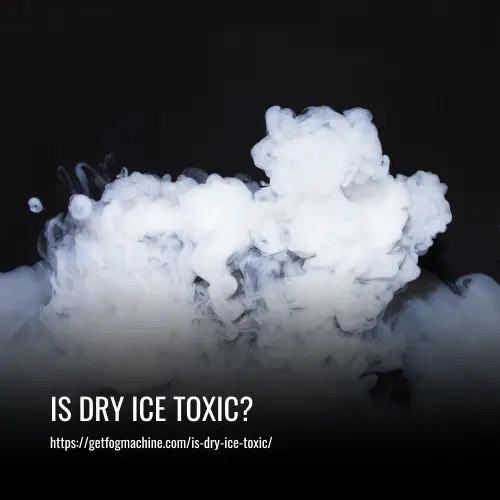Is Dry Ice Toxic? What You Need to Know
This post contains affiliate links. As an Amazon Associate, we earn from qualifying purchases.
Dry ice is a solid form of carbon dioxide, and it can be potentially toxic if not handled properly. When dry ice sublimes, it converts from a solid to a gas without passing through the liquid phase, producing carbon dioxide gas. In areas without proper ventilation, the buildup of gaseous carbon dioxide can displace oxygen, potentially leading to asphyxiation.
Direct contact with dry ice can also cause frostbite or “ice burn” due to its extremely cold temperatures. It is crucial to handle dry ice in a well-ventilated area, wear safety glasses and insulated gloves, and avoid ingesting or having direct contact with it.

What is Dry Ice
Dry ice is the solid form of carbon dioxide (CO2), with a temperature of -109.3°F (-78.5°C). It undergoes a process called sublimation, where it goes directly from a solid to a gas when exposed to room temperature air. This unique property allows dry ice to be used for various purposes.
The most common use of dry ice is to keep food cold during shipping or storage. Its extremely low temperature makes it an effective cooling agent, and it doesn’t melt like regular ice. Dry ice also finds applications in theatrical effects, cryotherapy, industrial cleaning processes, and more.
Handling dry ice requires caution, as its cold temperature can cause severe frostbite upon contact with skin. It should not be touched without insulated gloves or other protective gear. Moreover, because carbon dioxide gas is heavier than air, it can displace oxygen in poorly ventilated areas, leading to suffocation if inhaled in large quantities over time.
Despite its potential hazards, dry ice is widely used and valued for its unique properties. It has become an essential tool in various industries, offering cool effects and efficient cooling capabilities. However, it should always be handled with care, ensuring proper ventilation and personal protective equipment to mitigate any potential dangers.
Is Dry Ice Toxic
Dry ice, also known as frozen carbon dioxide, is commonly used for keeping food cold during shipping or storage. It is also used in other applications such as theatrical effects and industrial cleaning processes. While dry ice provides effective cooling, it is important to be aware of its potential risks and handle it with caution.
1. Potential Health Risks of Dry Ice Exposure
When handling dry ice, there are several potential health risks to consider. Inhaling large amounts of dry ice vapor can lead to respiratory problems, including difficulty breathing, dizziness, headaches, and even loss of consciousness. This is because carbon dioxide gas, which is released as dry ice sublimes from its solid form to gas, can displace oxygen in poorly ventilated areas, resulting in suffocation if inhaled in large quantities over time.
Furthermore, direct skin contact with dry ice can cause frostbite due to its extremely low temperature. It is crucial to wear protective clothing, such as insulated gloves and safety glasses when handling dry ice to prevent injury.
2. Precautions to Take When Handling Dry Ice
To handle dry ice safely, it is important to take certain precautions. Always wear protective clothing, including gloves and safety glasses, to prevent skin contact and injuries from extremely cold temperatures. Keeping your face away from the container containing dry ice helps avoid inhaling carbon dioxide vapor.
Additionally, it is crucial to never store or transport dry ice in airtight containers, as pressure buildup can lead to explosions. Adequate ventilation is essential to prevent the buildup of excess carbon dioxide gas and maintain a safe working environment.
3. Environmental Impact
While dry ice has numerous applications, it is important to consider its environmental impact. When exposed to air at room temperature, carbon dioxide gas is released into the atmosphere, contributing to climate change and global warming. Improper disposal of unused or expired dry ice can also pollute nearby water sources, as liquid carbon dioxide is highly soluble in water.
How to Store and Handle Dry Ice Safely
Storing and handling dry ice requires proper precautions to ensure safety. Here are some guidelines to follow:
1. Proper Storage Techniques for Dry Ice
Dry ice should be stored in a well-ventilated area, away from heat sources and combustible materials. It is recommended to use an insulated container, such as foam or cardboard, to maintain low temperatures and prevent any pressure buildup. Layering dry ice with newspaper helps absorb moisture and prevent issues later on.
2. Tips for Handling and Transporting Dry Ice Safely
When handling dry ice, always wear protective gloves and goggles to avoid frostbite. It is crucial to transport large amounts of dry ice in well-ventilated vehicles to prevent the build-up of carbon dioxide gas, which can lead to suffocation hazards. Containers designed for transporting dry ice, such as Styrofoam coolers, are recommended to maintain low temperatures while allowing some air circulation.
3. Additional Safety Measures
In addition to wearing protective gear, it is advisable to have a fire extinguisher nearby and a first aid kit in case of accidents involving flames or sparks. Dry ice can cause serious burns if exposed for too long without proper insulation, so it is essential to protect the skin with clothing or blankets.
How to Dispose of Used or Unused Dry Ice
Dry ice is a solid form of carbon dioxide that is used for various purposes, including cooling and fog effects. However, it is important to handle and dispose of dry ice properly to prevent harm to people and the environment.
1. Appropriate Disposal Methods for Used or Unused Dry Ice
The best way to dispose of dry ice is to allow it to evaporate completely in a well-ventilated area away from people and animals. This ensures that the carbon dioxide gas is safely released into the atmosphere.
If time does not permit waiting for the dry ice to fully evaporate, you can submerge it in water until all of the gas has been released. It is crucial to note that unused dry ice should never be placed in sealed containers or garbage bags, as this can result in dangerous pressure buildup, potentially causing injuries or property damage.
2. Regulations Regarding the Disposal of Used or Unused Dry Ice
Different regions may have specific regulations regarding the safe disposal of dry ice. For instance, some areas may prohibit disposal into sewers due to the risk of clogging from frozen carbon dioxide particles. It is advisable to contact your local waste management authority to obtain information on proper disposal methods applicable to your region.
3. Considering the environmental impact
Carbon dioxide is a greenhouse gas that contributes to global warming. Therefore, it is important to minimize emissions when disposing of dry ice. This can be achieved by ensuring that no excess gas escapes during transport and storage before final disposal at an approved facility designated by your local authorities.
Proper disposal of dry ice is not only essential for environmental protection but also necessary to comply with regulations. In the next section, we will discuss alternative uses for both using and storing dry ice.
Alternatives to Using and Storing Dry Ice
When it comes to alternatives to using and storing dry ice, there are a few options available. Each of these options has its own advantages and disadvantages that should be considered before making a decision.
1. Advantages and Disadvantages of Alternatives to Using and Storing Dry Ice
The main advantage of using an alternative to dry ice is that it eliminates the need for handling or storing dry ice, which can be dangerous due to its extremely low temperature. However, some alternatives may not provide the same cooling power level as dry ice. Additionally, depending on the type of alternative chosen, the cost may also be a factor in determining whether or not it’s worth switching from traditional methods.
2. Types of Alternatives to Using and Storing Dry Ice
There are several types of alternatives available when looking for ways to replace dry ice storage or use. These include gel packs, liquid nitrogen tanks, phase change materials (PCMs), insulated containers with cold packs inside them, and refrigerated shipping containers or trailers with built-in cooling systems.
Each option has its own pros and cons that must be taken into consideration before deciding which one is best suited for your needs. Gel packs tend to have lower upfront costs but require more frequent replacement. Liquid nitrogen tanks offer greater efficiency but come with higher initial costs and ongoing maintenance expenses.
PCMs are generally cheaper but provide less long-term cooling power. Insulated containers with cold packs offer portability but have high upfront costs and additional energy bills. Refrigerated shipping containers or trailers have superior insulation capabilities but require specialized equipment and ongoing maintenance expenses.
FAQs
No, dry ice is not poisonous to drink with. However, it is dangerous if ingested due to its extremely cold temperature. Ingesting dry ice can cause severe burns and tissue damage in the mouth and throat. It should never be consumed as it will quickly evaporate into a gas, which could lead to choking or suffocation.
Dry ice is generally considered safe to use in fog machines, humidifiers, and diffusers as long as it is handled with care. However, it can be dangerous if not used properly. Direct contact with dry ice can cause frostbite or other skin injuries. Inhaling dry ice vapors can irritate the lungs and throat. Ventilation and protective gear such as gloves and face masks should be used when handling dry ice.
No, dry ice cannot poison you. However, improper handling of dry ice can cause skin burns due to its extremely cold temperature. It is important to wear protective gloves, ensure adequate ventilation, and keep dry ice away from children and pets.
No, dry ice is not toxic to food. Dry ice is made of frozen carbon dioxide and does not contain any toxins or harmful substances. However, it should be handled properly to avoid skin contact and not consumed directly.
No, dry ice does not contain water. It is made up of frozen carbon dioxide and undergoes sublimation, turning directly into carbon dioxide gas when heated.
Dry ice is not dangerous if stored and used correctly, but it can present hazards due to its extremely cold temperature. It is important to handle dry ice with care and ensure proper ventilation.
Using dry ice alone or in combination with regular ice is safe. It is recommended to wrap the dry ice in newspaper to keep it separate and on top.
Dry ice, like carbon dioxide, is odorless and tasteless.
Dry ice is considered environmentally friendly as it does not release excess carbon dioxide into the environment. It is being used as a replacement for more environmentally destructive processes in various industries.
Conclusion
While dry ice is not technically toxic, it can be hazardous if handled improperly. Ingesting dry ice can cause severe burns and tissue damage, and direct contact with the skin can lead to frostbite or other injuries. Inhaling dry ice vapors can also irritate the lungs and throat.
Therefore, it is crucial to handle dry ice with caution and to use protective gear such as gloves and face masks. Adequate ventilation is also necessary to prevent the build-up of carbon dioxide gas. Dry ice should never be consumed directly or used in contact with food without proper precautions.
Despite these potential dangers, when used safely and with proper precautions, dry ice is a useful tool for creating cool effects or maintaining cold temperatures. It is important to educate oneself about the proper handling and disposal of dry ice to ensure safety for all involved.





